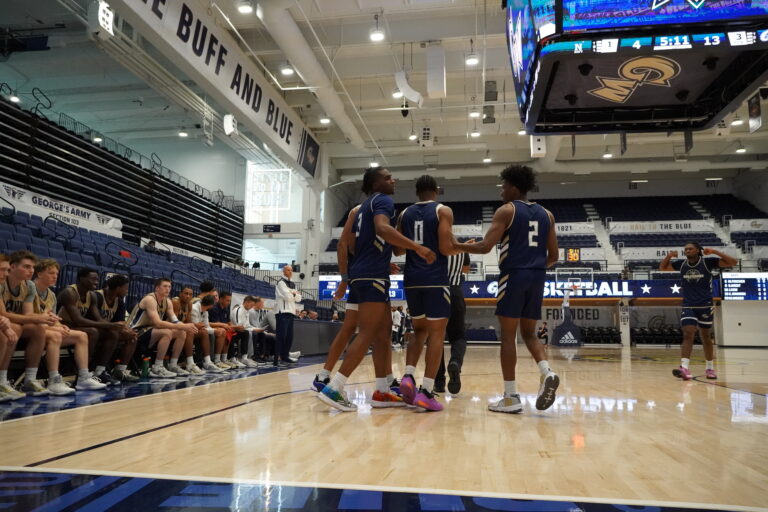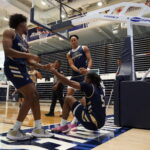Photo Credit: Kenan Orlovic
This story was part of our 2024-2025 season preview. If you’d like to read the full preview, please click here.
By: Abe Rothstein (@RothsteinAbe)
For any basketball fan, it is easy to realize that the game has completely changed. Gone are the days of slowly dribbling up the court, looking for a post up and possibly settling for a midrange jumper. For GW, those days are over.
Under Head Coach Chris Caputo, the Revs have been consistently playing at a faster pace. Under the three years with Jamion Christian at the helm, the Revolutionaries’ average tempo was 178th in the country, according to KenPom. Once Caputo took over, the Revs were 93rd and 65th in the nation in the same category during his first two years in Foggy Bottom.
There has been a lot of discussion as to how the faster tempo has impacted teams on both the offensive and defensive sides of the ball.
In the 2023-2024 seasons, there was not a direct correlation between a faster tempo and offensive rating. The top three tempo teams in the country were Western Kentucky, VMI (a GW opponent this season), and Bryant. All three teams finished with an offensive rating of 193rd, 360th and 268th, respectively.
Kentucky and Arizona were the lone tournament teams in the top 14 of tempo, where they would finish seventh and second in offense.
On the other hand, teams with the slowest tempo saw as much success. The 12th and 14th slowest tempo teams made runs deep into the NCAA tournament, look no further than South Carolina and Houston.
Caputo pointed out that some teams such as North Carolina under Roy Williams were successful in faster tempo play, and had a tremendous defense to help supplement the pace.
“On offense, they were going to punch the ball inside, on post ups, on back screens, lobs, on the offensive glass and in transition,” Caputo said. “And then defensively, they were going to pressure and were going to force you to put the ball on the ground and try to drive it into big, athletic guys who block shots.”
For teams, the game becomes a possession battle, and forcing turnovers is key to winning that fight.
In this day and age, the stat of points allowed per game does not tell the full story of whether or not a team is actually successful on the defensive end. Coaches now believe that points per possession is one of the most important statistics in basketball.
“Points per possession is the ultimate stat in basketball,” said GW assistant coach Matt Colpoys. “At the end of the day, you’re going to have basically the same amount of possessions as the other team.”
When teams have about the same number of possessions per game, it is crucial to limit opponents on those possessions.
A team such as the University of Virginia will allow fewer points per game than GW when the Cavaliers have nine fewer defensive possessions per game.
For the slowest-paced team in the country, UVA finished just 200th nationally in offensive rating but finished seventh in the country in defensive rating. Classic Tony Bennett basketball.
Despite the pace, Virginia finished with a 23-11 record and was able to limit opponents to fewer possessions and, more importantly, fewer points per possession.
“[Bennett’s] thing was, ‘Hey, we’re gonna play very slow on offense and keep you on defense,” Caputo said. “Play great defense, and at the end of the game, we’re going to have a low-possession game where our defense forced you into more difficult shots and our offense worked really, really hard to get great shots for us.”
Teams like UVA would average about 60 total possessions per game, while the average in college hoops sat around 68.5, according to KenPom.
Virginia’s stout defense hung their hats on their ability to force their opponents to shoot “low value” shots late in the shot clock, limiting their likelihood of scoring.
“Whoever gets the most high expected value shots generally wins,” said Chris Caputo. “Every team has their own shot chart that you could look at all the players on that team, and look at all the spots on the floor, you can factor in where the shots are contested or off the dribble.”
Still, the GW defense has been struggling over the last two seasons in the points-per-game category, but the team thrived when they limited points per possession.
When GW held opponents to less than 1.1 points per possession last season, they only lost three games.
The Revs overhauled their defense this offseason to limit those points per possession, heavily focusing their practices on the defensive side of the ball. To pair their transfers with players who are growing within the program, expect the defense to certainly take a step up this season.
“Jacoi [Hutchinson], Christian [Jones], Trey Moss, they have the speed, quickness, athleticism to do it,” said Caputo. “I do feel like there’s more guys out here who can move their feet and keep people in front of them. And as they get a little bit older, wiser, defensively, hopefully, it’ll pay dividends.”
On the offensive end, looking for those highest expected value shots will be key for the Revolutionaries this season. As good as James Bishop was at those contested midrange jumpers, they are not seen analytically as high-quality shots.
In a recent scrimmage before the season, fellow A-10 foe, Saint Louis, took every shot from either behind the arc or in the paint; no midrange jumpers were taken.
Take a look at this chart, made by Jack Godar on X.
The Revolutionaries will try to limit their midrange jumpers and instead focus on threes and points in the paint.
“Even with James Bishop, who’s a reasonably good mid range shooter, you know, we were top 50 in the country in not taking mid range shots,” Caputo said. “I’d like us to be in the top 25 there.”
Coaches say that rim attempts are the best quality shot you can get. Those attempts at the rim can lead to fouls, which then lead to free throws, making scoring extremely efficient. Creating an important presence in the paint opens up a ton for offenses all around.
“(Rim pressure) creates threes by the defense collapsing if we space properly, and threaten the defense with three pointers, then that rim, in theory, should be open,” Colpoys said.
The Revs plan on taking advantage of players such as Darren Buchanan Jr. being an unstoppable force in the paint.
“You’re kind of making the defense choose. Are they going to try and take away the rim? If they do, we’re going to get threes. If we space properly, and we have threes, then we will get rim attempts,” Colpoys said.
While mid range jumpers are still prevalent in the NBA with superstars such as Jalen Brunson and Kevin Durant making a living from there, it is unlikely we will see another midrange player without a three point shot like Sean Livingston.
In the NBA, the total number of jump shots has not changed, but Colpoys says they have just backed up. Not many David West shots, but stepped back to the three point line.
The earlier in the shot clock you shoot, the higher the form of possession is, transition is the most efficient offense.
Both the offensive and defensive sides of the ball in college have gone through major transformations. For the Revs this season, look for more points in the paint and three point attempts.
Don’t freak out if it seems as if GW is allowing a high amount of points per game on the eye test; the key for them is taking those high quality shots and creating turnovers to allow a low points per possession. That’s the new formula for winning basketball.


